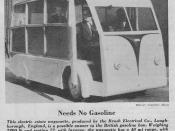Assessment of the Domestic Automobile Industry
Introduction
The domestic automotive industry has been playing a leading role in spurring growth in economies throughout the world since the industrial revolution. It is a sector characterized by not only tremendous potential growth, but also high profile trade disputes, and intense competition. This paper will detail an objective analysis on how different economic indicators have impacted the domestic automotive industry.
History and Overview of Domestic Automotive Industry
A timeline approach can be used to analyze the evolution of any major business. However, a look at how the domestic automobile industry evolved reveals a different time scale than of almost any industry today. The evolutionary stages took decades to play out. The major U.S. automobile industry took about three-quarters of a century to evolve however, early automobile executives were well aware of the need to forge a positive business cycle. (Wade, 2004, p. 3)
The late 1800s were a time of experimentation, as the first automobile pioneers struggled to grasp the potential of individualized, motorized transportation.
Ransom E. Olds and a handful of others established practical automobile businesses by the turn of the century. Their machines worked reasonably well, were accepted by a small but dedicated number of customers, and could be profitably produced.
The next 20 years carried the domestic automobile industry deep into the second stage of competition. In 1904, William C. Durant began building what would become General Motors with marginal benefit. Durant's strategy for GM, however, was based on acquisitions of early companies, marketing might, sales coverage, and product variety. Durant's captured the market share by pooling and integrating the production facilities of a variety of smaller companies. However, by 1920, General Motors had nearly collapsed because of the of Durant's complex collection of business entities inverse relationship of profit...



Great Paper!
This paper is well organizaed and structure.
Great Job!
2 out of 2 people found this comment useful.